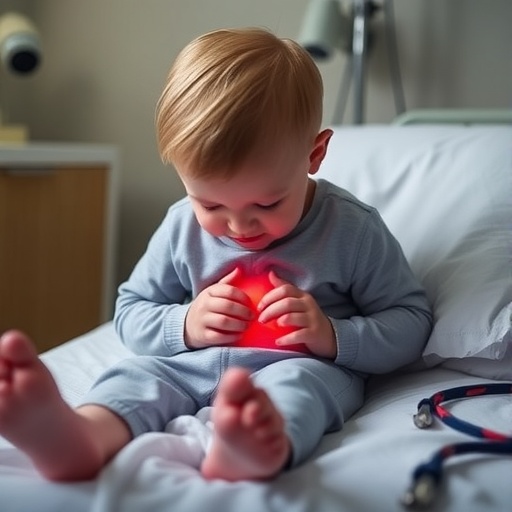In recent years, the survival rates for out-of-hospital pediatric cardiac arrest have stubbornly remained static, showing dishearteningly little improvement despite advances in medical technology and emergency response protocols. A pivotal study authored by Donohue and Fine, soon to be published in Pediatric Research, delves into the reasons behind these flatlined outcomes and makes an urgent call for sweeping reforms in prehospital care and resuscitation strategies. This investigation brings to light the pressing need to rethink the current systems and innovate the approach toward pediatric cardiac emergencies occurring outside of hospital settings.
Pediatric cardiac arrest, a rare but catastrophic event, presents unique challenges distinct from adult cases. Children’s physiological differences, variable causes of arrest, and the lower incidence of these emergencies complicate diagnosis, intervention, and outcomes. Unlike adults, who typically suffer cardiac arrests due to underlying coronary artery diseases or arrhythmias, children more commonly experience arrests secondary to respiratory failure, trauma, or sudden infant death syndrome. These nuances necessitate specialized treatment modalities which seem inadequately addressed in current prehospital protocols.
One of the most troubling trends highlighted in Donohue and Fine’s research is the lack of progress in survival rates despite the widespread implementation of advanced life support measures and public health campaigns aimed at increasing bystander CPR. Statistics indicate that survival to hospital discharge remains disconcertingly low, with neurological outcomes often compromised. The study underscores how traditional algorithms and emergency medical services (EMS) training remain largely modeled on adult cardiac care paradigms, leaving pediatric-specific needs marginalized or misunderstood.
This research rigorously evaluates EMS practices, revealing significant variability in how pediatric emergencies are managed. Dispatch systems often struggle with rapid recognition of pediatric arrest, leading to delays in initiating life-saving interventions. Moreover, disparities in EMS resource allocation and paramedic training focused on pediatric emergencies contribute to inconsistent quality of care across communities. The authors advocate for widespread adoption of pediatric-specific protocols integrated into the earliest stages of emergency response—from dispatch to field interventions.
In addition to procedural reforms, Donohue and Fine emphasize technological innovations that hold promise to transform prehospital pediatric resuscitation. Emerging portable monitoring devices tailored for children, capable of early detection of physiological deterioration, could enable quicker interventions. Similarly, advanced training simulators utilizing augmented reality technology offer paramedics immersive practice scenarios designed to enhance competence and confidence in managing these rare but critical events.
Crucially, the article argues for robust data collection and national registries specifically dedicated to pediatric out-of-hospital cardiac arrests. Present data gaps hinder comprehensive understanding of which interventions truly influence outcomes, impeding evidence-based improvements. Systematic long-term follow-up to assess neurological and functional status post-resuscitation is vital to refining care standards and tailoring rehabilitation resources accordingly.
The authors also highlight the potential of community engagement initiatives that go beyond traditional CPR training. Empowering caregivers, teachers, and laypersons in early recognition and response to pediatric distress could bridge the critical window before professional help arrives. Innovative educational campaigns leveraging digital platforms and gamified learning might increase retention and willingness to act in emergencies, ultimately saving lives.
A pivotal insight from the paper centers on the integration of multi-disciplinary expertise in emergency systems. Collaboration between pediatricians, emergency physicians, paramedics, and researchers ensures that protocols remain reflective of evolving scientific understanding and practical realities. This holistic approach could spur the development of refined triage criteria and adaptive treatment pathways customized to child age and underlying etiology.
Donohue and Fine acknowledge the inherent complexities in implementing widespread change but stress the urgency. The current plateau in survival rates signals that incremental adjustments are insufficient; bold, systemic reforms are necessary. This includes reallocation of funding towards pediatric emergency readiness, continuous professional development focusing on pediatric emergencies, and policy frameworks that mandate pediatric competence as a core EMS standard.
Furthermore, the study posits that leveraging artificial intelligence and machine learning could revolutionize emergency response decision-making. Predictive analytics integrated into dispatch and on-scene assessments may optimize resource deployment and personalize resuscitation efforts based on real-time data. Such technology-driven enhancements, coupled with human expertise, could overcome longstanding barriers in pediatric resuscitation effectiveness.
The societal impact of improving out-of-hospital pediatric cardiac arrest survival extends far beyond individual patients. It affects families, communities, and healthcare systems by reducing long-term disability, minimizing emotional trauma, and lowering economic burdens associated with chronic care. Therefore, the ramifications of reforming prehospital pediatric care align with broader public health goals and value-based care paradigms.
Importantly, Donohue and Fine call for cross-national collaboration to harmonize pediatric emergency care standards. Variability in protocols and outcomes worldwide suggests an opportunity to learn from international best practices and co-develop globally applicable guidelines. This cooperative model could accelerate knowledge dissemination and foster innovations that transcend geographical boundaries.
The paper encourages funding agencies and governments to prioritize pediatric emergency research and infrastructure as part of national health agendas. Targeted investments could catalyze technological development, educational outreach, and data infrastructure essential to breaking the current survival stalemate. A commitment to this cause signals recognition of children’s unique healthcare needs and societal responsibility to safeguard their well-being.
In sum, the forthcoming study by Donohue and Fine constitutes a clarion call to the medical community, policymakers, and emergency response systems worldwide. By elucidating the multifaceted challenges and proposing a comprehensive reform blueprint, it paves the way for dramatic improvements in survival rates and outcomes for children facing out-of-hospital cardiac arrest. The time for bold action has arrived, demanding innovation, dedication, and collaboration to rewrite the future of pediatric emergency care.
Subject of Research: Out-of-hospital pediatric cardiac arrest survival rates and prehospital resuscitation reform
Article Title: Flat lines in survival from out-of-hospital pediatric cardiac arrest: making the case for bold reform in prehospital care and resuscitation.
Article References:
Donohue, K.J., Fine, A.M. Flat lines in survival from out-of-hospital pediatric cardiac arrest: making the case for bold reform in prehospital care and resuscitation. Pediatr Res (2025). https://doi.org/10.1038/s41390-025-04477-0
Image Credits: AI Generated




